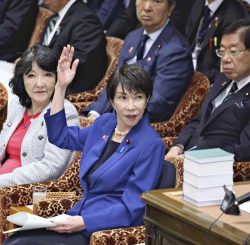Tensions Rising Around Maritime Border Claimed by China; Globally Recognized ‘Freedom of Overflight’ Under Threat

A Jiangkai-II class frigate of the Chinese Navy sails in the East China Sea on Dec. 30.
2:00 JST, January 29, 2024
In recent years, China has repeatedly attempted to change the status quo in the East and South China Seas by force.
Beijing appears to be focusing on the effective operation of the air defense identification zone (ADIZ) that China unilaterally declared over an area of the East China Sea, which could further heighten military tensions with Japan and the United States.
I recently observed the area over the East China Sea from a Yomiuri Shimbun aircraft and saw Chinese warships in constant deployment.
On the morning of Dec. 30, we were flying over an area near Miyakojima island in Okinawa Prefecture, which is outside the ADIZ claimed by China. Suddenly, I heard a voice break into our airborne radio communications.
“This is a Chinese naval ship,” the voice said in Chinese. “Leave immediately. Leave immediately.”
The voice on the radio gave a similar warning in English, and appeared to be trying to drive away aircraft flying within the zone. The orders weren’t directed at our aircraft, but I could feel the tension on board. I witnessed up-close how China is taking actions based on its unilateral claims.
In the afternoon that day, we confirmed the presence of a Jiangkai-II class frigate of the Chinese Navy in waters about 20 kilometers into China’s ADIZ. The frigate, equipped with high-performance radar and known for its high attack capabilities, was seen in the deep blue East China Sea, about 230 kilometers northeast of the Senkaku Islands in Okinawa Prefecture.
About 5 kilometers away from the Chinese frigate, I could see a Maritime Self-Defense Force vessel, the Mogami-class frigate Mikuma.
The Mikuma was landing a ship-based helicopter, as if to counter China’s unilateral claims and make clear its intention to protect freedom of flight.
In late December, the Yomiuri Shimbun sent an aircraft over the East China Sea a total of six times over four days, conducting a wide search for Chinese warships. As a result, the warship was photographed near the border of ADIZ claimed by China.
Beijing enacted a law in 1992 that declared the Senkaku Islands to be its territory but did not take any notable steps to claim the waters as its own until recently. However, in 2008, China began dispatching government vessels into Japanese territorial waters around the Senkaku Islands, attempting to change the status quo.
In recent years, there have been instances in which Chinese naval vessels entered Japan’s contiguous zone — approximately 22 kilometers outside territorial waters — near the Senkaku Islands.
China has its own territorial claims in the South China Sea as well. Surrounding countries such as the Philippines are protesting these claims, which in fact have no legal basis. China uses a method called the “salami-slicing strategy,” whereby it builds up small changes over a long period to make the changes a fait accompli.
Under international law, the principle is that “freedom of overflight” is recognized on the high seas, in the same manner as “freedom of navigation.” On the flight I took, we entered China’s ADIZ without following the procedures required by China but experienced no interference from the Chinese side.
Since China established the ADIZ, some commercial aircraft have avoided flying through it.
I believe nothing serious has happened so far because the Japanese side is keeping things in check, as I saw with the Mikuma. China is continuing to expand its military, however, and Japan cannot continue to rely solely on responding at the scene.
The Japanese government needs to maintain a sense of urgency and continue to demonstrate that it will not tolerate China’s attempts to change the status quo. It must further strengthen its deterrence and response capabilities in cooperation with the United States and like-minded countries.
Freedom of flight must not be obstructed on the high seas. I felt this strongly as I was flying over the East China Sea on my way home.
"Politics" POPULAR ARTICLE
-

Japan to Charge Foreigners More for Residence Permits, Looking to Align with Western Countries
-

China Would Cut Off Takaichi’s ‘Filthy Head’ in Taiwan Crisis, Diplomat Allegedly Says in Online Post
-

If China Were to Impose Blockade on Taiwan, Existential Crisis Could Be Triggered, Japan’s Prime Minister Takaichi Says
-

Japan to Tighten Screening of Foreigners’ Residential Status by Providing Information of Nonpayment of Taxes
-

Takaichi Cabinet Approval Holds at 72% as Voters Back Aggressive Fiscal Stimulus, Child Benefits
JN ACCESS RANKING
-

Govt Plans to Urge Municipalities to Help Residents Cope with Rising Prices
-

Japan Resumes Scallop Exports to China
-

Japan Prime Minister Takaichi Vows to Have Country Exit Deflation, Closely Monitor Economic Indicators
-

Japan to Charge Foreigners More for Residence Permits, Looking to Align with Western Countries
-

Japan GDP Down Annualized 1.8% in July-Sept.
























